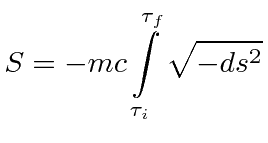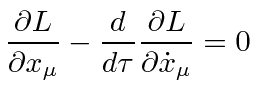Next: Conserved Energy and Angular Up: A Little General Relativity Previous: The Singularity in Schwarzschild Contents
Particles follow a geodesic through the curved spacetime.
This is analogous to taking a great circle route on the curved surface of the earth.
We minimize
![]() to take the shortest path, the geodesic.
to take the shortest path, the geodesic.

We may take the Action back to an integral over proper time if that is more convenient.

This is a simple version of the geodesic equation that will be adequate for our purposes. General Relativity will need to deal with the problem of the correct geodesic in a more complex but also more generally correct way.
The Euler-Lagrange equation to minimize this Action is

 and
and
